A U-turn is a vehicular maneuver in which you turn in the middle of the road to travel the opposite direction in a single, seamless motion.
It looks like this –
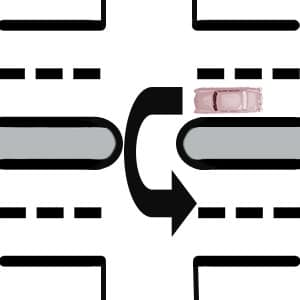
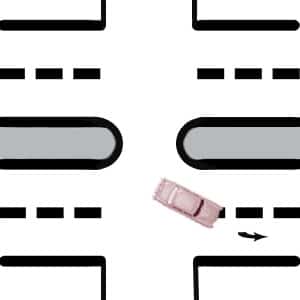
U-turning is legal in most places in most states in the U.S., though local laws may prohibit U-turning in certain situations.
A U-turn is the simplest driving turnabout you can perform on the road, but doing it well and safely is key.
Making a U-Turn
A U-turn may be performed while already in motion or from a stop.
Many U-turns start from stops at traffic lights and are curved around medians.
A U-turn can only truly be completed when the road is wide enough to turn completely around (180°) without stopping.
If you have to stop to complete it, it turns into a three-point turn.
To make a U-turn:
- Check the roadway ahead, to both sides, and any streets or drives that connect with the road on which you are making the U-turn to ensure they are clear.
- Press the gas to start moving forward and turn the steering wheel fully to the left to keep your turn as tight as possible.
- Continuously check all pathways onto the road to ensure no one is pulling out of a street or drive.
- Move into a single lane as quickly as possible if you are performing the U-turn on a road with multiple lanes. This is most common, as most two lane roads don’t provide enough space to complete a U-turn.
- Continue driving forward.
Broken U-Turn
A broken U-turn occurs when a driver can’t keep a tight enough turn (or there isn’t enough width in the road) to complete the turn in one, seamless motion.
In this instance, a driver must reverse to back away from whatever impedes their path and then go forward again to complete the turn.
When a U-turn breaks, it is known as a 3-point turn.
U-Turn Driving Test
No state explicitly states a driver must perform a U-turn to pass the driving test. (Three-point turns are more common.)
However, U-turns are legal in most states in the U.S. and a driving instructor can ask you to make one.
Due to this, you should know how to perform both a U-turn and a three-point turn (this can be used to save a U-turn if you don’t make the turn all in one go) before taking a driving test.
U-Turn Signs
U-turn signs may be posted in areas where U-turns are legal to provide guidance and warning to drivers.
How a U-turn sign looks depends on the circumstances of the road.
On a split highway, a U-Turn sign may be posted to indicate there is a crossover ahead that can be used to turn around on the roadway.
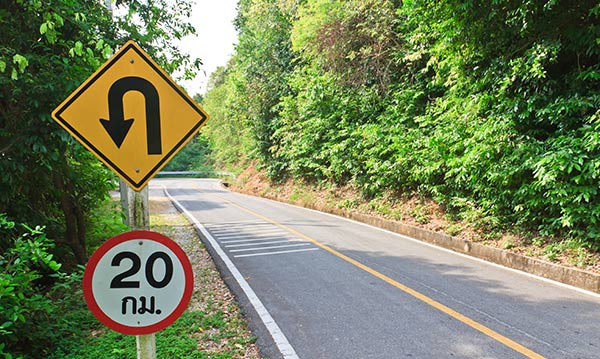
On a road with multiple left turn lanes at a stoplight, a U-Turn sign may be posted to indicate which lanes may be used to make a U-turn. (It is almost always the inside lane – furthest left – only.)
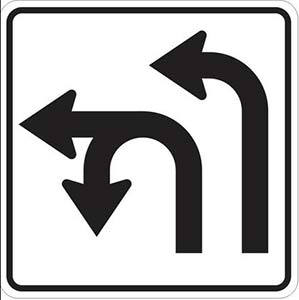
Just because there is no road sign for U-turns at an intersection doesn’t make it illegal.
In most states which allow U-turns, U-turns are legal at any intersection unless otherwise posted. (But still only applies to the inside turn lane.)
No U Turn Signs
Just like U-turn signs may be posted to guide and warn drivers, No U-turn signs may be posted at intersections or cross-overs to inform drivers they are not legal at that intersection.
Again, No U-turn signs looks different depending on where they are posted.
On a split highway (like U.S. interstates), No U-turn signs typically appear like this –
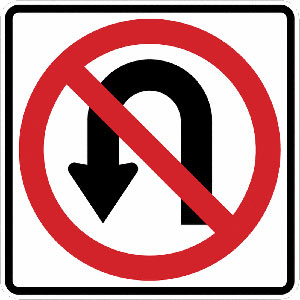
On a road with more than one left turn lane, No U-turn signs typically look like this –
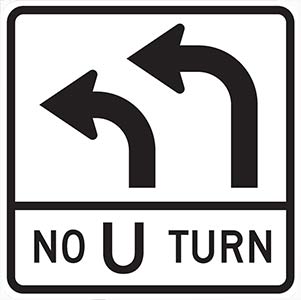
Even in states that allow U-turns in most places, U-turns are generally forbidden at intersections where visibility is poor, speed limits are high, and it is too dangerous to make one.
U-Turn Rules and Laws by State
U.S. U-turn laws are pretty simple, because the laws are the same in 49 out of 50 states.
In the simplest of terms, you may make a U-turn wherever it is safe to do so and doesn’t impede the flow of traffic (as long as there is no sign posted stating a U-turn is forbidden).
Some other U-turn rules do apply, which may alter other usual rules of the road.
These U-turn rules include:
- It is legal to make a U-turn even when there is a double yellow line (if you have sufficient visibility).
- It is illegal to make a U-turn across a triple yellow line. (Roads with triple yellow lines are those deemed extremely dangerous with too many curves and hills for visibility.)
- It is legal to make a U-turn at most intersections (unless otherwise posted).
- It is illegal to make a U-turn when the light is red, regardless of whether the road is clear.
- It is legal to make a U-turn on divided highways where cross-over drives are provided.
- It is illegal to make a U-turn on a divided road with no cross-overs or to cut across medians.
- U-turns may only be made on two-way streets.
- U-turns in residential districts are legal as long as you have enough clearance to make the turn without impeding traffic. (Many states set this clearance at 200 feet.)
- U-turns in business districts are legal at stoplights and cross-overs.
States these U-turn laws apply to are:
- Alabama
- Alaska
- Arizona
- Arkansas
- California
- Colorado
- Connecticut
- Delaware
- Florida
- Georgia
- Hawaii
- Idaho
- Illinois
- Indiana
- Iowa
- Kansas
- Kentucky
- Louisiana
- Maine
- Maryland
- Massachusetts
- Michigan
- Minnesota
- Mississippi
- Missouri
- Montana
- Nebraska
- Nevada
- New Hampshire
- New Jersey
- New Mexico
- New York
- North Carolina
- North Dakota
- Ohio
- Oklahoma
- Pennsylvania
- Rhode Island
- South Carolina
- South Dakota
- Tennessee
- Texas
- Utah
- Vermont
- Virginia
- Washington
- West Virginia
- Wisconsin
- Wyoming
Some states also have dedicated U-turn lanes.
Georgia and Texas both have protected U-turn lanes, which are typically found on access roads running alongside interstates, and allow drivers to make U-turns outside the regular flow of traffic.
What States are U-Turns Illegal?
There is only one state in the U.S. that has very divergent U-turn laws from the rest of the country, and that state is Oregon.
Are U-Turns Legal in Oregon?
U-turns are not totally illegal in Oregon, but they are far more regulated.
Unlike the other 49 states, where U-turns are legal at traffic lights unless otherwise posted, U-turns are illegal in Oregon at an intersection controlled by a traffic light unless there is a sign explicitly stating U-turns are allowed.
For the most part, the rest of the U-turn laws in Oregon are the same as in the other states with minor variations.
You may make a U-turn at an intersection not controlled by a traffic light as long as you have sufficient visibility.
The state sets sufficient visibility at 500 feet in cities.
Outside cities, sufficient visibility for a U-turn is set at 1,000 feet.
U-Turn Right of Way
You never have the right of way when performing a U-turn.
It doesn’t matter if U-turns are legal at the intersection or you have a green light.
This is the trickiest thing about performing a U-turn.
You are responsible for making sure the way is clear and you can perform a U-turn safely.
U-Turn Yield to Right Turn or Oncoming Traffic
No place is right of way more important than at an intersection where it is both legal to make a U-turn and legal to turn right on red, or in a business district with crossover/turn lanes where U-turns are allowed and drivers are pulling out of business drives at the same time.
In the instance where you want to perform a U-Turn while someone is waiting at an adjacent light or stop sign to turn right, the person turning right on red (yes, even on red) has the right of way.
In the instance where you want to perform a U-Turn while someone is waiting to pull out of a business, the person pulling out of the business has the right of way.
The reason a driver performing a U-turn holds more responsibility is because a U-turn is considered an unexpected maneuver on the road, which makes it difficult for other drivers to predict.
Right Turn Yield to U-Turn
There are two conditions in which a driver making a U-turn does have the right of way.
One, if the driver performing the U-Turn starts into the U-turn before the driver turning right on red makes it to the intersection.
In this instance, the intersection is not considered clear, and since a driver turning right on red should only turn if the road is clear, they would be in violation of the law.
Two, if there is a sign posted stating drivers turning right on red must yield to U-turns. The signs look like this –
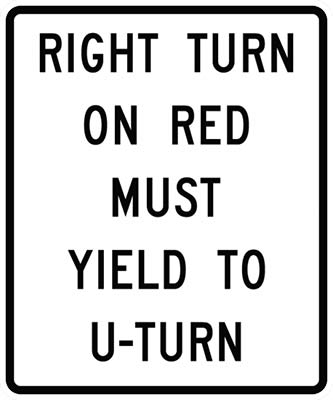
Otherwise, when performing a U-turn, you are the responsible driver.
Dangers of U-Turns
U-turns are considered one of the most dangerous driving maneuvers you can perform, especially in cities with heavy traffic.
Essentially, it’s a form of left turn, and left turns are responsible for an over-sized share of traffic accidents.
Per the National Highway Traffic Safety Administration, intersection-related crashes are 40% of all car accidents, and left turns are the biggest culprit in intersection accidents, causing 22.2% of all crashes.
In cities and traffic-heavy areas, U-turns are rarely the best course of action, and should be avoided if at all possible.
